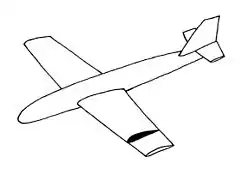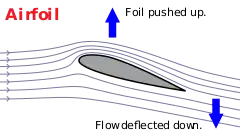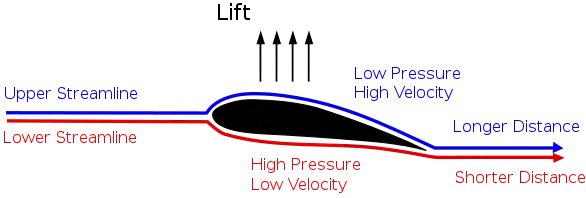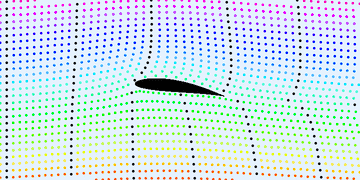升力
升力(英語:)。当流体流经一个物体的表面时会对其产生一个表面力,而则这个力垂直于流体流向的分力即為升力[1],与之相对的则是平行于流体流向的阻力。如果流体是空气时,它产生的升力便叫做空气动力。航空器要想升到空中,必须能产生能克服自身重力的升力[2]。

升力主要是靠機翼對空氣取得,飛機的機翼斷面形狀有很多種類,依照每種形狀適用於不同功用的飛機,飛機的機翼從斷面來看,通常機翼上半部曲面及下半部曲面不一樣,通常為上半部曲面弧長較長,空氣流經飛機機翼截面,因空氣流過機翼表面時被一分為二,經過機翼上表面的空氣是沿着曲线运动的(因为机翼上表面是弯曲的),所以会产生负压(负压提供空气沿曲线运动所需的向心力),而經過機翼下面的空氣是沿着比较平缓的表面运动的(机翼下表面相对平直),所以不会产生负压(参见簡化的物理解釋),机翼下部压力高,上部压力小,壓力高的地方會往壓力低的部分移動,這就是升力的由來。[3]
解释
升力取決於空氣的密度,速度的平方,空氣的黏性以及空氣的可壓縮性,空氣流經物體的表面積,物體的形狀,以及物體與氣流的夾角。一般來說,升力與物體外形,氣流夾角,空氣的黏性,以及空氣的可壓縮性這幾項的關聯是非常複雜的。
升力,就是向上的力。从機翼流线谱中看出:相对气流稳定而连续地流过機翼时,上下表面的流线情况不同。上表面流线是弯曲的,其气会产生负压、因此压力小;而下表面流线较平直的,其气流不会产生负压,压力较大。因此,产生了上下压力差。这个压力差就是空气动力(R),它垂直流速方向的分力就是升力(Y)。流过各个剖面升力总合就是机翼的升力。升力维持飞机在空中飞行。
機翼升力的簡化物理解釋

機翼是流線型的,能夠產生比阻力大得多的升力[4]。平板可以產生升力,但其升力不如流線型機翼來得大,阻力也略高。
有幾種方法可以解釋機翼如何產生升力。某些方法較為嚴格複雜,有些則是錯的[5][6][7][8][9]。例如,基於牛頓運動定律的解釋和基於伯努利原理的解釋皆可以解釋升力[10][11]。

流體偏轉及牛頓定律
氣流經過機翼時,機翼會對空氣施加向下的力,根據牛頓第三定律,空氣必須對機翼施加大小相等、方向相反的反作用力,也就是方向朝上的升力[12][13][14][15]。
氣流在經過機翼時改變方向,沿著向下彎曲的路徑流動。根據牛頓第二定律,這種流動方向的改變,需要機翼對空氣施加向下的力。牛頓第三定律則要求空氣對機翼施加向上的力; 因此產生了與方向變化相反的反作用力——升力[16][17][18][19][20][21]。
氣流之所以向下偏轉,並非僅僅由機翼的下表面造成,機翼上方的氣流也佔了很大的因素。
流速增加及伯努利原理
伯努利原理指出,流體的壓力和速度之間存在著直接的數學關係,因此,如果知道氣流中每一點的速度,就可以計算出壓力,反之亦然[22]。對於任何產生升力的機翼,必然存在壓力不平衡,即頂部的平均氣壓低於底部。伯努利原理指出,這種壓力差必須伴隨著速度差。

質量守恆
由理論和實驗中觀察到的流動型態,上表面流速增加的原因,可以用流管夾緊和质量守恒來解釋[23]。
對於不可壓縮流,質量不會被創造或破壞,所以當流管變窄時,為了保持流量恆定,在每個流管內,體積流率(例如每分鐘的體積單位)必須保持恆定,變窄區域內會增加流速,以滿足質量守恆原理[24]。
在機翼的情形,因為向上流動和圍繞機翼,所以上部流管收縮。由於質量守恆,流速必須隨著流管面積的減小而增大。同樣,下部流管會膨脹,導致流速變慢[23]。
根據伯努利原理,上表面流速較快,因此上表面壓力小於流速較慢的下表面壓力。這種壓力差產生了向上的淨空氣動力。
簡化解釋的限制
產生升力需要維持垂直和水平方向上的壓力差,故同時需要「氣流的向下偏轉」以及「符合伯努利原理的流速變化」。因此上述的簡化解釋不夠完整,因為它們只根據其中一項來定義升力。根據細節,簡化的解釋還有其他缺陷。
基於流體偏轉和牛頓定律的解釋是正確的,但仍不完整。它並沒有解釋,機翼如何使比它實際碰觸部分還遠得多的流體也能產生偏轉。此外,它也沒有解釋水平方向上的壓力差是如何維持的。也就是說,它忽略了相互作用中「伯努利原理所影響的部分」[25]。
而伯努利原理的解釋,建立在上表面有更高的流速,但未能正確解釋是什麼導致了流速加快:
- 有時,人們會提出一個幾何參數來說明為什麼流管的尺寸會發生變化:有人斷言,與底部相比,頂部“阻礙”或“壓縮”空氣的程度更大,因此流管更窄。對於底部平、頂部彎的傳統機翼情形,這感覺是直觀的。但它並沒有解釋平板、對稱機翼、帆船帆布或倒飛的傳統機翼是如何產生升力的,基於收縮量計算升力的嘗試也無法預測實驗結果[29][30][31][32]。
- 常見的等過境時間版本是錯誤的,解釋見下文。
只考慮伯努利的解釋意味著,速度差是由壓力差以外的原因所引起,且根據伯努利原理,速度差會再導致壓力差,但是這種隱含的單向因果關係是一種誤解,壓力和速度之間真正的因果關係是相互的。最後,只有伯努利的解釋不能解釋垂直方向上的壓力差是如何維持的。也就是說,它們忽略了相互作用中向下偏轉氣流的部分[33]。
替代解釋、誤解和爭議
對於機翼升力的產生,人們提出了許多不同的解釋,大多數是為了向大眾解釋升力現象。雖然這些解釋可能與上述解釋有共通點,但可能會引入額外的假設和簡化。有一些解釋引入了被證明是錯誤的假設,如「相同過境時間假設」。一些則是使用了有爭議的術語,如“康達效應”。
基於相同過境時間的錯誤解釋
在基礎或常見的資料中,“等過境時間”理論經常用於描述升力,該理論錯誤地認為,在機翼前緣分離的氣團必須在後緣重新匯合,迫使沿較長上表面飛行的空氣速度更快。然後引用伯努利原理得出結論,沿著機翼底部移動的氣流速度較慢,氣壓一定會更高,從而推動機翼上升[34]。
然而,沒有物理原理要求等過境時間這個條件成立,實驗結果則表明該假設是錯誤的[35][36][37][38][39][40]。事實上,機翼上方產生升力的空氣運動速度比等過境理論預測的要快得多[41]。此外,這個理論也違反了牛頓第三運動定律,因為它描述了作用在機翼上的力,卻沒有伴隨著反作用力[42]。
空氣必須同時到達後緣的論斷有時被稱為“等時間謬論”[43][44][45][46][47]。

康達效應之爭議
起初,康達效應指的是,流體射流(jet)會維持「附著在偏離流體的相鄰彎曲表面」的趨勢,由此將環境空氣捲入流體。 這種效應命名自羅馬尼亞的空氣動力學家康達(HenriCoandă),他在多項專利中充分應用了該效應。
更廣泛地說,一些人認為,這種效應包括了任何「流體邊界層會去附著在曲面上」的趨勢,而不只是專用於流體射流的邊界層。在這個更廣泛的意義上,某些人用康達效應解釋為何氣流會維持在機翼上的附著狀態[48]。例如,Jef Raskin[49]描述了一個簡單的演示,用一根吸管吹氣,使氣流通過機翼的上表面,機翼因此向上偏轉,從而證明康達效應能夠產生升力。這個演示以流體噴射(吸管所排放的氣流)緊臨曲面(翼面),正確展示了康達效應。然而,上表面的氣流是一個複雜的、充滿渦流的混合層,而與此同時,下表面的氣流卻是靜止的。因此,這個演示的物理性質與一般在機翼上的氣流有很大的不同[50]。這種用法在一些流行的空氣動力學參考文獻中也曾出現過[48][49],而這是對“康達效應”充滿爭議的用法。更公認的空氣動力學領域觀點是,康達效應被定義在比上述更受限的意義上[50][51][52],沿著上表面的氣流只是反映出「缺乏了邊界層的分離」; 因此它不是康達效應的一個例子[53][54][55][56]。
基本的升力因素
更全面的物理解釋
在“機翼升力的簡化物理解釋”中,有兩種主要解釋:一種是基於氣流向下偏轉(牛頓定律),另一種是基於壓力差而伴隨流速變化(伯努利原理)。這兩種現像中的任何一種,都在一定程度上辨識了升力的面貌,但未解釋其他重要部分。更全面的解釋包括向下偏轉和壓力差(包括與壓力差相關的流速變化),以及對氣流更詳細地研究[57]。
機翼表面的升力
機翼形狀和攻角共同作用,使機翼在氣流經過時對空氣施加向下的力。根據牛頓第三定律,空氣必須對機翼施加一個大小相等、方向相反(向上)的力,也就是升力[58]。
當機翼表面出現壓力差,空氣會對機翼表面施加淨力[59]。流體中的壓力在絕對意義上總是正的[60],因此,必須把壓力看作是推,而不是拉。因此,在機翼的任何地方,無論上表面或下表面,機翼會被壓力往內推擠。為了對機翼的存在作出反應,氣流通過時,會降低上表面壓力以及增加下表面壓力。因為向上推的下表面壓力比向下推的上表面的壓力來得大,最終的結果就是向上的升力[59]。
壓力差直接造成作用於機翼表面的升力; 然而,要理解壓力差是如何產生的,就需要理解氣流在更大範圍內的作用[61]。
機翼周圍的更寬流動

機翼在大範圍內影響氣流的速度和方向,產生一種稱為速度場的模式。當機翼產生升力,機翼前面的流體向上偏轉,而機翼上方和下方氣流向下偏轉,機翼後方的氣流則再次向上偏轉,遠拋在後的氣流與迎面而來的氣流處於相同的狀態。機翼上方的氣流加快,而機翼下方的氣流減慢。加上前面空氣向上偏轉和後面空氣向下偏轉,這就構成了氣流的淨循環成分。向下偏轉及流速變化明顯,並延伸到一個很廣的區域,正如右邊的氣流動畫。氣流方向和速度上的差異在靠近機翼處最大,在遠高於和低於機翼的地方逐漸減小。速度場的所有這些特徵也出現在升力氣流的理論模型中[62][63]。
壓力也受到大面積的影響,形成一種稱為壓力場的非均勻壓力模式。當機翼產生升力時,機翼上方有一個低壓擴散區,機翼下方通常有一個高壓擴散區,如圖中的等壓線(恆壓曲線)所示。作用於表面的壓力差只是這個壓力場的一部分。

壓力差與流速變化的相互作用
不均勻的壓力,在壓力由高到低的方向上,對空氣施力。 在機翼周圍的不同位置,如在等壓線圖中箭頭方向所示,力的方向是不同的。 機翼上方的空氣被推向低壓區域中心,機翼下方的空氣則被從高壓區域中心向外推送。
根據牛頓第二定律,空氣朝受力方向加速。因此,在等壓線圖中,垂直箭頭指出,機翼上下方的空氣被加速或向下偏轉,因此,在氣流動畫中,非均勻壓力可能是可見氣流向下偏轉的原因。為了產生這種向下轉彎,機翼必須有一個正攻角,或是其後部向下彎曲,就像帶有拱形的機翼。注意,上表面的氣流向下翻轉,是由於上面壓力大於下面壓力而將空氣向下推的結果。有些解釋(請參閱“康達效應”)表明,對於向下偏轉,粘度將起到關鍵的作用,不過這是錯誤的解釋。(請參閱“康達效應之爭議”)。
機翼前方的箭頭,表示前方的氣流向上偏轉;後方的箭頭則表示,機翼後方的氣流會在向下偏轉後,再次向上偏轉。這些偏移可以在氣流動畫中看到。
機翼前方和後方的箭頭也表明,當空氣通過機翼上方的低壓區,會在進入時加速,離開時減速。空氣通過機翼下方的高壓區時,則是相反的情況——它先是減速,然後加速。因此,非均勻壓力也是氣流動畫中流速變化的原因。而流速變化與伯努利原理一致,伯努利原理認為在無粘性的穩定流動中,低壓力意味著高速度,而高壓力意味著低速度。
因此,流動方向和速度的變化是由非均勻壓力直接引起的。但這種因果關係不僅是單向的,而是在兩個方向上同時奏效。空氣的運動受壓力差的影響,但壓力差的存在取決於空氣的運動。因此,這種關係是一種互惠的相互作用:氣流根據壓差改變速度或方向[64],而壓差是由空氣對速度或方向變化的阻力維持的。只有當有東西可以推動時,壓力差才會存在。在空氣動力流動中,當空氣因為壓力差而加速時[65],壓力差會推動空氣的慣性。這就是為什麼空氣質量是計算的一部分,以及為什麼升力取決於空氣密度。
為了維持機翼表面升力所需的壓力差,需要在機翼周遭的大範圍內維持不均勻的壓力模式。這就要求維持垂直和水平方向的壓力差,既需要氣流的向下偏轉,也需要根據伯努利原理造成的流速變化。壓力差與氣流的方向和速度變化相互作用,相互支撐。壓力差理所當然來自於牛頓第二定律,也來自於流體沿著機翼主要向下傾斜的輪廓流動這一事實。而空氣具有質量這點,對相互作用也至關重要[66]。
簡化解釋之不足
產生升力既需要流體向下偏轉,又需要與伯努利原理一致的流速變化。上述簡化物理解釋中給出的任一解釋,只用其中一種方式來解釋升力,因此只能解釋現象的一部分,而未解釋剩下的部分[67]。
量化升力
壓力積分
當機翼表面上的壓力分佈已知時,確定總升力需要將表面局部元素對壓力的貢獻累加,每個元素具有其自身的局部壓力值。因此,總升力是在垂直於遠場流動的方向上在機翼表面上的壓力的積分[68]。
- S是機翼的投影(平面形狀)區域,測量值與平均氣流垂直;
- n是指向機翼的正常單位矢量;
- k是垂直單位向量、垂直於自由流方向。
升力係數
升力取決於機翼的大小,大致與機翼面積成比例。通過量化升力係數給定機翼的升力通常很方便 ,它定義了機翼單位面積的整體升力[69]。
對於特定迎角的機翼,特定流量條件下產生的升力:
- L是升力
- ρ是空氣密度
- v是速度或真實空速
- S是翼面俯視面積
- 是所需迎角、馬赫數和雷諾數的升力係數
升力的數學理論
升力的數學理論建立在連續流體力學的基礎上,該理論假設空氣作為連續流體流動[70][71][72]。升力的成因是根據物理學的基本原理,其中最相關的有以下三條原理[73]:
- 動量守恆,這是牛頓運動定律的結果,尤其是牛頓第二定律,將空氣中的合力和動量時變率聯繫起來。
- 質量守恆,包括機翼表面不被周圍流動的空氣所滲透的假設。
- 能量守恆,也就是說能量既不會被創造也不會被破壞。
因為機翼影響其周圍廣闊區域的流動,力學守恆定律以偏微分方程的形式體現,並結合一組邊界條件,必須滿足在機翼表面和遠離機翼之條件[74]。
要預測升力,需要通過計算流體動力學(CFD)的方法,求解特定機翼形狀和流動條件的方程,這通常需要大量的計算,只有在計算機上才有辦法實現。當CFD要決定淨空氣動力時,會由CFD決定出在所有表面元素的壓力及剪切力,並對其導致的力作"壓力積分"。
納維-斯托克斯方程(NS)提供了可能最精確的升力理論,但實際上,在機翼表面邊界層,捕捉湍流的影響需要犧牲一定的精度,並且需要使用雷诺平均纳维-斯托克斯方程(RANS)。此外,也發展了其他更簡單但不太準確的理論。
三維流程
圍繞三維機翼的流動還涉及其他重要問題,尤其是與翼尖有關的問題。對於低展弦比的機翼,如典型的三角翼,二維理論的模型可能較差,三維流動效應占了主導地位[75]。即使對於高展弦比的機翼,有限翼展的三維效應也會影響整個翼展,而不會只靠近翼尖。
相關
- 爬升
参考资料
- . NASA Glenn Research Center. [March 4, 2009]. (原始内容存档于2009-03-09).
- ,谢础,贾玉红,黄俊,吴永康. . 北京航空航天大学出版社. 2008: 3. ISBN 978-7-81124-428-1.
- . NASA. [2015-02-06]. (原始内容存档于2015-02-16) (英语).
- Clancy, L. J., Aerodynamics, Section 5.2
- "There are many theories of how lift is generated. Unfortunately, many of the theories found in encyclopedias, on web sites, and even in some textbooks are incorrect, causing unnecessary confusion for students." NASA . [20 April 2012]. (原始内容存档于2014-04-27).
- "Most of the texts present the Bernoulli formula without derivation, but also with very little explanation. When applied to the lift of an airfoil, the explanation and diagrams are almost always wrong. At least for an introductory course, lift on an airfoil should be explained simply in terms of Newton’s Third Law, with the thrust up being equal to the time rate of change of momentum of the air downwards." Cliff Swartz et al. Quibbles, Misunderstandings, and Egregious Mistakes - Survey of High-School Physics Texts THE PHYSICS TEACHER Vol. 37, May 1999 p. 300 页面存档备份,存于
- "One explanation of how a wing . . gives lift is that as a result of the shape of the airfoil, the air flows faster over the top than it does over the bottom because it has farther to travel. Of course, with our thin-airfoil sails, the distance along the top is the same as along the bottom so this explanation of lift fails." The Aerodynamics of Sail Interaction by Arvel Gentry Proceedings of the Third AIAA Symposium on the Aero/Hydronautics of Sailing 1971 (PDF). [12 July 2011]. (原始内容 (PDF)存档于2011-07-07). 已忽略未知参数
|df=(帮助) - "An explanation frequently given is that the path along the upper side of the aerofoil is longer and the air thus has to be faster. This explanation is wrong." A comparison of explanations of the aerodynamic lifting force Klaus Weltner Am. J. Phys. Vol.55 January 1, 1987
- "The lift on the body is simple...it's the reaction of the solid body to the turning of a moving fluid...Now why does the fluid turn the way that it does? That's where the complexity enters in because we are dealing with a fluid. ...The cause for the flow turning is the simultaneous conservation of mass, momentum (both linear and angular), and energy by the fluid. And it's confusing for a fluid because the mass can move and redistribute itself (unlike a solid), but can only do so in ways that conserve momentum (mass times velocity) and energy (mass times velocity squared)... A change in velocity in one direction can cause a change in velocity in a perpendicular direction in a fluid, which doesn't occur in solid mechanics... So exactly describing how the flow turns is a complex problem; too complex for most people to visualize. So we make up simplified "models". And when we simplify, we leave something out. So the model is flawed. Most of the arguments about lift generation come down to people finding the flaws in the various models, and so the arguments are usually very legitimate." Tom Benson of NASA's Glenn Research Center in an interview with AlphaTrainer.Com . [26 July 2012]. (原始内容存档于2012-04-27).
- "Both approaches are equally valid and equally correct, a concept that is central to the conclusion of this article." Charles N. Eastlake An Aerodynamicist’s View of Lift, Bernoulli, and Newton THE PHYSICS TEACHER Vol. 40, March 2002 (PDF). [10 September 2009]. (原始内容存档 (PDF)于2009-04-11).
- Ison, David, , Plane & Pilot, [January 14, 2011], (原始内容存档于2015-09-24)
- "...the effect of the wing is to give the air stream a downward velocity component. The reaction force of the deflected air mass must then act on the wing to give it an equal and opposite upward component." In: Halliday, David; Resnick, Robert, , John Wiley & Sons: 378
- Anderson and Eberhardt (2001)
- Langewiesche (1944)
- "When air flows over and under an airfoil inclined at a small angle to its direction, the air is turned from its course. Now, when a body is moving in a uniform speed in a straight line, it requires force to alter either its direction or speed. Therefore, the sails exert a force on the wind and, since action and reaction are equal and opposite, the wind exerts a force on the sails." In: Morwood, John, , Adlard Coles Limited: 17
- "Lift is a force generated by turning a moving fluid... If the body is shaped, moved, or inclined in such a way as to produce a net deflection or turning of the flow, the local velocity is changed in magnitude, direction, or both. Changing the velocity creates a net force on the body." . NASA Glenn Research Center. [July 7, 2009]. (原始内容存档于2011-07-05).
- "Essentially, due to the presence of the wing (its shape and inclination to the incoming flow, the so-called angle of attack), the flow is given a downward deflection. It is Newton’s third law at work here, with the flow then exerting a reaction force on the wing in an upward direction, thus generating lift." Vassilis Spathopoulos - Flight Physics for Beginners: Simple Examples of Applying Newton’s Laws The Physics Teacher Vol. 49, September 2011 p. 373
- "The main fact of all heavier-than-air flight is this: the wing keeps the airplane up by pushing the air down." In: Langewiesche - Stick and Rudder, p. 6
- "Birds and aircraft fly because they are constantly pushing air downwards: L = Δp/Δt where L= lift force, and Δp/Δt is the rate at which downward momentum is imparted to the airflow." Flight without Bernoulli Chris Waltham THE PHYSICS TEACHER Vol. 36, Nov. 1998 (PDF). [4 August 2011]. (原始内容存档 (PDF)于2011-09-28).
- Clancy, L. J.; Aerodynamics, Pitman 1975, p. 76: "This lift force has its reaction in the downward momentum which is imparted to the air as it flows over the wing. Thus the lift of the wing is equal to the rate of transport of downward momentum of this air."
- "...if the air is to produce an upward force on the wing, the wing must produce a downward force on the air. Because under these circumstances air cannot sustain a force, it is deflected, or accelerated, downward. Newton's second law gives us the means for quantifying the lift force: Flift = m∆v/∆t = ∆(mv)/∆t. The lift force is equal to the time rate of change of momentum of the air." Smith, Norman F. . The Physics Teacher. 1972, 10 (8): 451. Bibcode:1972PhTea..10..451S. doi:10.1119/1.2352317.
- Smith, Norman F. . School Science and Mathematics. 1973, 73 (3): 181. doi:10.1111/j.1949-8594.1973.tb08998.x.
- Anderson (2004) - Section 5.19.
- "The effect of squeezing streamlines together as they divert around the front of an airfoil shape is that the velocity must increase to keep the mass flow constant since the area between the streamlines has become smaller." Charles N. Eastlake An Aerodynamicist’s View of Lift, Bernoulli, and Newton THE PHYSICS TEACHER Vol. 40, March 2002 (PDF). [10 September 2009]. (原始内容存档 (PDF)于2009-04-11).
- McLean 2012, Section 7.3.3.12
- "There is no way to predict, from Bernoulli's equation alone, what the pattern of streamlines will be for a particular wing." Halliday and Resnick Fundamentals of Physics 3rd Ed. Extended p. 378
- "The generation of lift may be explained by starting from the shape of streamtubes above and below an airfoil. With a constriction above and an expansion below, it is easy to demonstrate lift, again via the Bernoulli equation. However, the reason for the shape of the streamtubes remains obscure..." Jaakko Hoffren Quest for an Improved Explanation of Lift American Institute of Aeronautics and Astronautics 2001 p. 3 (PDF). [26 July 2012]. (原始内容 (PDF)存档于2013-12-07).
- "There is nothing wrong with the Bernoulli principle, or with the statement that the air goes faster over the top of the wing. But, as the above discussion suggests, our understanding is not complete with this explanation. The problem is that we are missing a vital piece when we apply Bernoulli’s principle. We can calculate the pressures around the wing if we know the speed of the air over and under the wing, but how do we determine the speed?" How Airplanes Fly: A Physical Description of Lift David Anderson and Scott Eberhardt . [26 January 2016]. (原始内容存档于2016-01-26).
- "The problem with the 'Venturi' theory is that it attempts to provide us with the velocity based on an incorrect assumption (the constriction of the flow produces the velocity field). We can calculate a velocity based on this assumption, and use Bernoulli's equation to compute the pressure, and perform the pressure-area calculation and the answer we get does not agree with the lift that we measure for a given airfoil." NASA Glenn Research Center . [26 July 2012]. (原始内容存档于2012-07-17).
- "A concept...uses a symmetrical convergent-divergent channel, like a longitudinal section of a Venturi tube, as the starting point . . when such a device is put in a flow, the static pressure in the tube decreases. When the upper half of the tube is removed, a geometry resembling the airfoil is left, and suction is still maintained on top of it. Of course, this explanation is flawed too, because the geometry change affects the whole flowfield and there is no physics involved in the description." Jaakko Hoffren Quest for an Improved Explanation of Lift Section 4.3 American Institute of Aeronautics and Astronautics 2001 (PDF). [26 July 2012]. (原始内容 (PDF)存档于2013-12-07).
- "This answers the apparent mystery of how a symmetric airfoil can produce lift. ... This is also true of a flat plate at non-zero angle of attack." Charles N. Eastlake An Aerodynamicist’s View of Lift, Bernoulli, and Newton (PDF). [10 September 2009]. (原始内容存档 (PDF)于2009-04-11).
- "This classic explanation is based on the difference of streaming velocities caused by the airfoil. There remains, however, a question: How does the airfoil cause the difference in streaming velocities? Some books don't give any answer, while others just stress the picture of the streamlines, saying the airfoil reduces the separations of the streamlines at the upper side. They do not say how the airfoil manages to do this. Thus this is not a sufficient answer." Klaus Weltner Bernoulli's Law and Aerodynamic Lifting Force The Physics Teacher February 1990 p. 84.
- McLean 2012, Section 7.3.3.12
- "The airfoil of the airplane wing, according to the textbook explanation that is more or less standard in the United States, has a special shape with more curvature on top than on the bottom; consequently, the air must travel farther over the top surface than over the bottom surface. Because the air must make the trip over the top and bottom surfaces in the same elapsed time ..., the velocity over the top surface will be greater than over the bottom. According to Bernoulli's theorem, this velocity difference produces a pressure difference which is lift." Bernoulli and Newton in Fluid Mechanics Norman F. Smith The Physics Teacher November 1972 Volume 10, Issue 8, p. 451
- "Unfortunately, this explanation [fails] on three counts. First, an airfoil need not have more curvature on its top than on its bottom. Airplanes can and do fly with perfectly symmetrical airfoils; that is with airfoils that have the same curvature top and bottom. Second, even if a humped-up (cambered) shape is used, the claim that the air must traverse the curved top surface in the same time as it does the flat bottom surface...is fictional. We can quote no physical law that tells us this. Third—and this is the most serious—the common textbook explanation, and the diagrams that accompany it, describe a force on the wing with no net disturbance to the airstream. This constitutes a violation of Newton's third law." Bernoulli and Newton in Fluid Mechanics Norman F. Smith The Physics Teacher November 1972 Volume 10, Issue 8, p. 451 . [4 August 2011]. (原始内容存档于2012-03-17).
- Anderson, David, , New York: McGraw-Hill: 15, 2001, ISBN 978-0-07-136377-8,
The first thing that is wrong is that the principle of equal transit times is not true for a wing with lift.
- Anderson, John. . Boston: McGraw-Hill Higher Education. 2005: 355. ISBN 978-0072825695.
It is then assumed that these two elements must meet up at the trailing edge, and because the running distance over the top surface of the airfoil is longer than that over the bottom surface, the element over the top surface must move faster. This is simply not true
- . [10 June 2012]. (原始内容存档于2012-06-30). Cambridge scientist debunks flying myth UK Telegraph 24 January 2012
- . National Committee for Fluid Mechanics Films/Educational Development Center. [January 21, 2009]. (原始内容存档于2016-10-21). A visualization of the typical retarded flow over the lower surface of the wing and the accelerated flow over the upper surface starts at 5:29 in the video.
- "...do you remember hearing that troubling business about the particles moving over the curved top surface having to go faster than the particles that went underneath, because they have a longer path to travel but must still get there at the same time? This is simply not true. It does not happen." Charles N. Eastlake An Aerodynamicist’s View of Lift, Bernoulli, and Newton THE PHYSICS TEACHER Vol. 40, March 2002 PDF 页面存档备份,存于
- "The actual velocity over the top of an airfoil is much faster than that predicted by the "Longer Path" theory and particles moving over the top arrive at the trailing edge before particles moving under the airfoil." Glenn Research Center. . NASA. March 15, 2006 [August 12, 2010]. (原始内容存档于2014-04-27).
- "...the air is described as producing a force on the object without the object having any opposite effect on the air. Such a condition, we should quickly recognize, embodies an action without a reaction, which is, according to Newton’s Third Law, impossible." Norman F. Smith Bernoulli, Newton, and Dynamic Lift Part I School Science and Mathematics, 73, 3, March 1973 Smith, Norman F. . School Science and Mathematics. November 30, 1972 [19 January 2015]. (原始内容存档于2015-01-19).
- A false explanation for lift has been put forward in mainstream books, and even in scientific exhibitions. Known as the "equal transit-time" explanation, it states that the parcels of air which are divided by an airfoil must rejoin again; because of the greater curvature (and hence longer path) of the upper surface of an aerofoil, the air going over the top must go faster in order to 'catch up' with the air flowing around the bottom. Therefore, because of its higher speed the pressure of the air above the airfoil must be lower. Despite the fact that this 'explanation' is probably the most common of all, it is false. It has recently been dubbed the "Equal transit-time fallacy".. [July 7, 2009]. (原始内容存档于2009-06-03).
- ...it leaves the impression that Professor Bernoulli is somehow to blame for the "equal transit time" fallacy... John S. Denker. . 1999 [July 7, 2009]. (原始内容存档于2009-11-20).
- The fallacy of equal transit time can be deduced from consideration of a flat plate, which will indeed produce lift, as anyone who has handled a sheet of plywood in the wind can testify. Gale M. Craig. . [July 7, 2009]. (原始内容存档于2009-08-02).
- Fallacy 1: Air takes the same time to move across the top of an aerofoil as across the bottom. Peter Eastwell, (PDF), The Science Education Review, 2007, 6 (1) [July 14, 2009], (原始内容存档 (PDF)于2009-11-28)
- "There is a popular fallacy called the equal transit-time fallacy that claims the two halves rejoin at the trailing edge of the aerofoil." Ethirajan Rathakrishnan Theoretical Aerodynamics John Wiley & sons 2013 section 4.10.1
- Anderson, David; Eberhart, Scott, , 1999 [June 4, 2008], (原始内容存档于2016-01-26)
- Raskin, Jef, , 1994 [2019-08-25], (原始内容存档于2007-09-28)
- Auerbach, David, , Eur. J. Phys., 2000, 21 (4): 289, Bibcode:2000EJPh...21..289A, doi:10.1088/0143-0807/21/4/302
- Denker, JS, , [18 August 2008], (原始内容存档于2009-03-02)
- Wille, R.; Fernholz, H., , J. Fluid Mech., 1965, 23 (4): 801, Bibcode:1965JFM....23..801W, doi:10.1017/S0022112065001702
- Auerbach (2000)
- Denker (1996)
- Wille and Fernholz(1965)
- White, Frank M., 5th, McGraw Hill, 2002
- McLean (2012), Section 7.3.3
- Langewiesche (1944)
- Milne-Thomson (1966), Section 1.41
- Jeans (1967), Section 33.
- McLean 2012, Section 7.3.3.7
- Clancy (1975), Section 4.5
- Milne-Thomson (1966.), Section 5.31
- McLean (2012), Section 3.5
- McLean 2012, Section 7.3.3.9"
- McLean 2012, Section 7.3.3.9
- McLean 2012, Section 7.3.3.12
- Anderson (2008), Section 5.7
- Anderson, John D., 5th, McGraw-Hill: 257, 2004, ISBN 978-0-07-282569-5
- Batchelor (1967), Section 1.2
- Thwaites (1958), Section I.2
- von Mises (1959), Section I.1
- "Analysis of fluid flow is typically presented to engineering students in terms of three fundamental principles: conservation of mass, conservation of momentum, and conservation of energy." Charles N. Eastlake An Aerodynamicist’s View of Lift, Bernoulli, and Newton THE PHYSICS TEACHER Vol. 40, March 2002 (PDF). [10 September 2009]. (原始内容存档 (PDF)于2009-04-11).
- White (1991), Chapter 1
- Milne-Thomson (1966), Section 12.3
